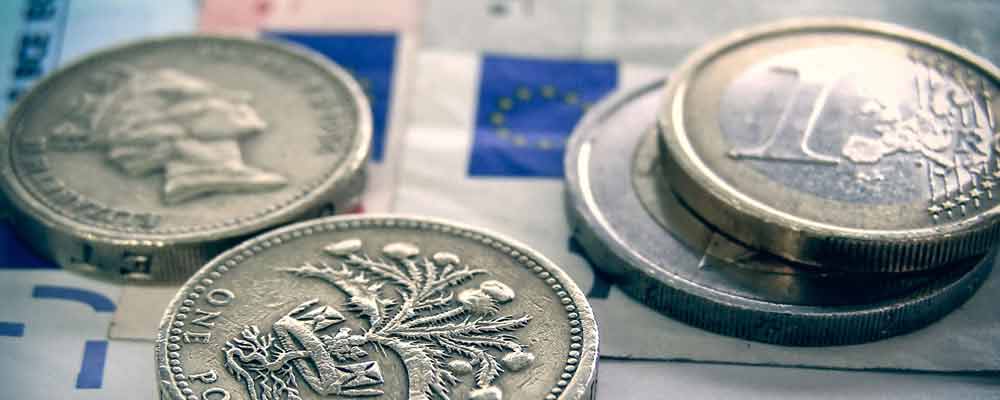- Euro (EUR) Exchange Rates Struggle on Brexit Uncertainty – Will there be contagion?
- Sterling (GBP) Rates Rebound – UK political landscape predicted to limit gains
- US Dollar (USD) Declines on Risk-On Trade – Domestic data to have a reduced impact
- Market Turmoil Set to Continue – Brexit fallout sees bond yields decline significantly
During Tuesday’s European session the British Pound rebounded from multi-year lows as traders took advantage of its comparatively low trade weighting. However, the uncertainty surrounding the UK’s political and economic landscape is likely to see GBP exchange rates resume depreciation.
The Euro, meanwhile, strengthened after risk-on trade saw asset prices fall.
(Previously Updated @ 09:15)
The UK’s surprising choice to vote to leave the European Union has sent shockwaves through financial markets and triggered EUR GBP exchange rate gains. Although volatility has cooled slightly in comparison to Friday’s turbulence, risk off trade has caused safe-haven assets to surge, with yields from developed nations’ bonds declining rapidly amid Brexit uncertainty.
Since the result of the referendum was announced, the EUR/GBP exchange rate has surged from a low of 0.7610 to a high of 0.8344.
Conversely the EUR/USD exchange rate has dropped from 1.1425 to a low of 1.0949.
Towards the close of Monday’s European session, the EUR GBP exchange rate advanced by around 2.5%, whilst the EUR USD exchange rate declined by around -0.9%.
If the notable volatility present in financial markets since the UK’s decision to Brexit continues, we can expect to see further significant shifts in EUR/GBP and EUR/USD exchange rates.
Uncertainty Fuelled by British Political Upheaval as Pound Sterling (GBP) Exchange Rates Dive on Brexit Fallout
Following the UK’s Brexit vote the Pound tumbled to multi-year lows versus its peers, with the subsequent slight rebound forecast to be unsustainable presently.
Against safe-haven assets such as the Japanese Yen and US Dollar, Sterling continues to experience sizable depreciation.
British stocks have also taken a pounding as investors shy away until more is known regarding the UK’s future outlook.
One major issue clouding the UK’s future is significant issues regarding the UK’s political landscape with the Brexit outcome causing division not only within political parties but across the nation as well.
The resignation of Prime Minister David Cameron before triggering Article 50 is a major issue for investors as there could potentially be long delays before any negotiations begin.
EU member states will be keen for a swift exit to limit the fallout, so any delays could see the UK ousted prematurely before any rock solid plans are put in place.
In an attempt to calm markets, Chancellor George Osborne stated that the UK is in a position of strength and there had been contingency plans put in place in the event of a Brexit.
Regarding the process of the UK’s exit from the EU, Osborne said;
‘Only the UK can trigger Article 50. And in my judgement, we should only do that when there is a clear view about what new arrangements we are seeking with our European neighbours. In the meantime, during the negotiations that will follow, there will be no change to people’s rights to travel and work and to the way our goods and services are traded or to the way our economy and financial system is regulated.’
Euro (EUR) Exchange Rates Hurt by Brexit Fallout as Safe-Haven Demand Pushes Bond Yields Lower
Although the single currency is holding a 2-year high against the Pound, it has struggled versus most of its major peers.
One of the major concerns for investors is the rise of populist movements throughout Europe and the potential that Brexit will spur other EU member states to hold referendums of their own.
Greece is a prime candidate for triggering a EU referendum, especially as a recent Greek referendum on austerity was completely ignored by the government.
There is a growing fear that the EU will attempt to deter contagion by making the UK an example and imposing harsh penalties on trade. This would be a dangerous move given that the UK is Europe’s best customer, and many European companies require British exports.
Another significant issue for those invested in the Euro is the spike in bond prices amid safe-haven demand.
The European Central Bank’s (ECB) asset purchase programme has already been criticised due to the lack of bonds for purchase and the quality of debt already purchased.
‘Yields were down around 10 basis points from Friday’s close across all maturities, as prices sharply outperformed equivalent German debt. Ten-year yields <GB10YT=RR> had dropped to a record low 0.985 percent by 0841 GMT, while 20-year yields hit a low of 1.729 percent and 30-year yields sank to 1.845 percent,’ said reporter David Milliken.
Safe-haven demand has also pushed the US Dollar higher, forcing the Euro lower thanks to negative correlation.
US Dollar (USD) Exchange Rates Advance as Brexit Provokes Risk-Off Trade
Since it emerged that the UK voted for Brexit the US Dollar has seen marked appreciation, especially against Sterling and other risk-correlated assets.
This will not be a welcome development for the Federal Reserve, however, as overvaluation could cause further delays to a benchmark interest rate hike.
‘This comes in an environment where the US economy was not that strong and the Fed is clearly thinking about reassessing the whole trajectory of rates anyway,’ said Lewis Alexander, US economist at Nomura. ‘You add this on top and they are not doing anything for a while.’
Given the rampant demand for safe-haven assets, US ecostats are unlikely to be hugely influential over Dollar exchange rates.
However, for those invested in the USD Markit’s Services and Composite PMIs will be of interest.
The Euro to Pound Sterling (EUR GBP) exchange rate was trending within the range of 0.8200 to 0.8326 during Monday’s European session.
The Euro to US Dollar (EUR USD) exchange rate was trending within the range of 1.0983 to 1.1084.



